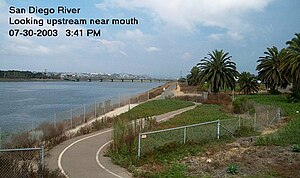Our website is made possible by displaying online advertisements to our visitors.
Please consider supporting us by disabling your ad blocker.
San Diego River
| San Diego River | |
|---|---|
 Looking upstream near mouth | |
| Location | |
| Country | United States |
| State | California |
| Region | San Diego County |
| Physical characteristics | |
| Source | Cuyamaca Mountains |
| • location | 5 miles (8 km) northwest of Julian, California |
| • coordinates | 33°07′09″N 116°39′00″W / 33.11917°N 116.65000°W[1] |
| • elevation | 3,750 ft (1,140 m) |
| Mouth | Mission Bay |
• location | Community of Ocean Beach, San Diego, California |
• coordinates | 32°45′37″N 117°12′45″W / 32.76028°N 117.21250°W[1] |
• elevation | 13 ft (4.0 m)[1] |
| Length | 52 mi (84 km) |
| Basin size | 420 sq mi (1,100 km2)[2] |
| Discharge | |
| • average | 38.3 cu ft/s (1.08 m3/s) |
| • minimum | 0 cu ft/s (0 m3/s) |
| • maximum | 94,500 cu ft/s (2,680 m3/s) |
The San Diego River is a 52 mi (84 km) river in San Diego County, California. It originates in the Cuyamaca Mountains northwest of the town of Julian, then flows to the southwest until it reaches El Capitan Reservoir, the second-largest reservoir in the river's watershed at 112,800 acre-feet (139,100,000 m3). Below El Capitan Dam, the river runs west through Santee and San Diego. While passing through Tierrasanta it goes through Mission Trails Regional Park, one of the largest urban parks in America.
It flows near Mission San Diego de Alcalá. The river's valley downstream from there is known as Mission Valley for that reason. The valley forms a transportation corridor for Interstate 8 and the San Diego Trolley's Green Line. The river discharges into the Pacific Ocean near the entrance to Mission Bay, forming an estuary.
- ^ a b c U.S. Geological Survey Geographic Names Information System: San Diego River
- ^ "Boundary Descriptions and Names of Regions, Subregions, Accounting Units and Cataloging Units". U.S. Geological Survey. Retrieved 2010-08-22.
Previous Page Next Page



